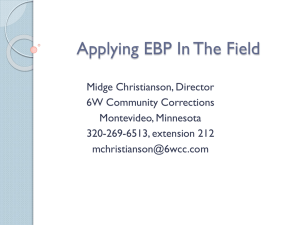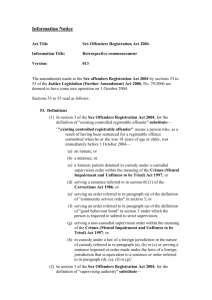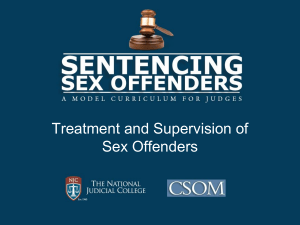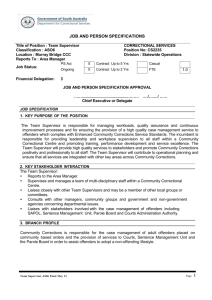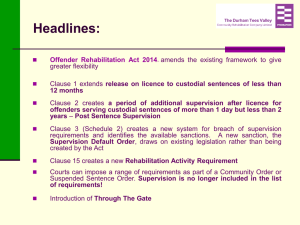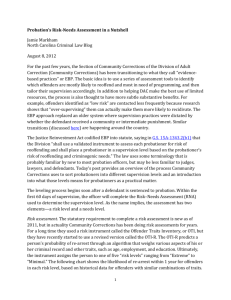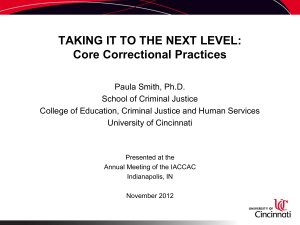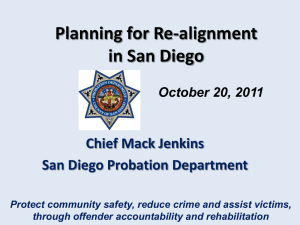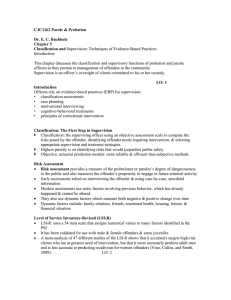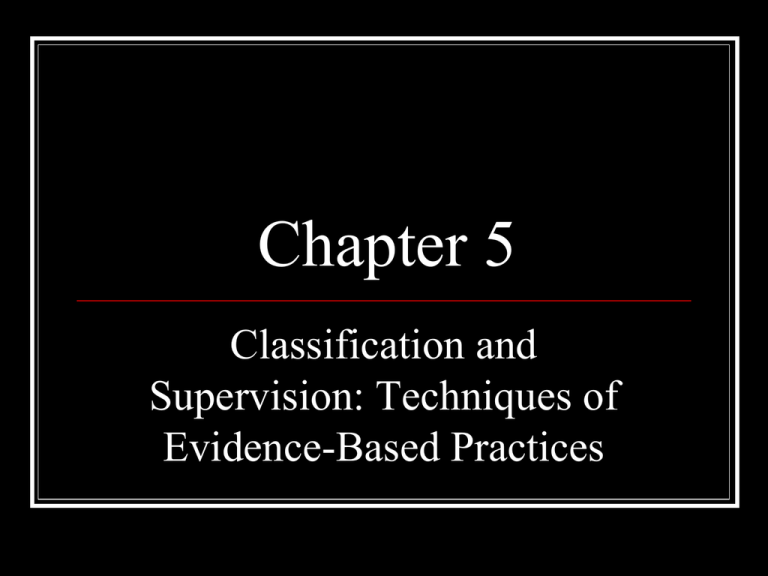
Chapter 5
Classification and
Supervision: Techniques of
Evidence-Based Practices
Introduction
This chapter discusses the classification and
supervisory functions of probation and parole
officers as they pertain to management of offenders
in the community.
Supervision is an officer’s oversight of clients
committed to his or her custody.
LO: 1
Classification: The First
Step in Supervision
Classification consists of the supervising officer using an
objective assessment scale to compute the risks posed by the
offender, identifying offender needs requiring intervention,
and selecting the appropriate supervision and treatment
strategies.
Highest priority is placed on identifying risks that would likely
jeopardize public safety if not addressed.
LO: 1
Risk Assessment
Risk assessment provides a measure of the probationer or
parolee’s degree of dangerousness to the public and also
measures the offender’s propensity to engage in future
criminal activity.
The first generation assessments relied on interviewing the
offender and using case-by-case anecdotal information to
make the decision about risk.
The second generation assessments primarily use static
questions about previous behavior, which has already
happened and cannot be altered.
LO: 2
Risk Assessment, Con’t.
Third generation assessments include both static
and dynamic factors, which aid in measuring
both negative and positive offender change over
time.
Dynamic factors include family relations,
friends, emotional health, housing, leisure, and
financial situation.
LO: 2
Risk Assessment, Con’t.
Third generation assessments are the Offender
Inventory Assessment (OIA) and the Level of
Service Inventory-Revised (LSI-R).
A meta-analysis of 47 different studies of the LSI-R
shows that it accurately targets high-risk clients who
are at greatest need of intervention, but that it more
accurately predicts adult men and is less accurate at
predicting recidivism for women offenders (Vose,
Cullen, and Smith, 2008).
LO: 2
Identifying Treatment Needs
The officer identifies those characteristics,
conditions, or behaviors that limit motivation
and may lead to criminal behavior.
Treatment activities are defined as actions taken
by the supervising officer intended to bring
about rehabilitation and reintegration into the
law-abiding community.
LO: 2
Identifying Treatment Needs,
Con’t.
Treatment needs include drug or alcohol abuse, mental
illness, anger management or education or vocational
deficiencies.
Sources of information that may be used to identify
treatment needs include the presentence report, prison
disciplinary records and the prerelease plan, physical
or medical health evaluations, records of drug or
alcohol abuse and other related criminal conduct,
financial history, and residential history.
LO: 2
The Supervision Case Plan
Developing the Case Plan
Supervision issues addressed in the plan may
involve:
Conditions imposed by the court
Risk control
Treatment
LO: 3
Implementing the Case Plan:
Surveillance
Surveillance means ascertaining that the
offenders are meeting the conditions of
supervision imposed by the court or parole
board.
The most common form of surveillance is
maintaining contact through face-to-face
meetings with each client in the office setting.
LO: 3
Levels of Supervision
Most classification systems use the traditional
categories of maximum, medium and minimum.
The categories specify the smallest amount of contact
requirements.
Factors of contacts include:
Type of contact
Location of contact
Frequency of contact
LO: 4
Caseload Management
Caseload and Workload Standards
A caseload is the number of individuals or cases one
officer can effectively supervise
The more intensive the supervision, the lower the caseload
The APPA recommends a workload standard of 120 hours
per month
The workload standard concept is preferable to allow for
comparison, research and interpreting work to legislators
and others
LO: 4
Principles of Effective Correctional
Intervention
Paul Gendreau (1996) published the principles of effective
intervention, which is currently considered the basis by
which correctional treatment programs should operate.
There are a total of 8 principles, which are that treatment
services should:
1. Be intensive, occupying 40 to 70% of each day for 3 to 9 months
2. Contain cognitive-behavioral components to prepare the mind for the
behavioral change
LO: 3
Principles of Effective Correctional
Intervention, Con’t.
3. Match the program level with client abilities or what the
client can relate to according to gender, age, cultural
background and risk level. Higher risk level clients will make
greater strides.
4. Have positive reinforcements that should exceed punishments
by a ratio of 4:1
5. Have minimum education and experience requirements for
staff
LO: 3
Principles of Effective Correctional
Intervention, Con’t.
6. Teach clients to replace criminal networks with prosocial
ones
7. Provide relapse prevention and aftercare
8. Evaluate the program and assess the compliance of programs
to the previous 7 principles by using the Correctional
Program Assessment Inventory (CPAI)
LO: 3
Cognitive-Behavioral Therapy
(CBT)
CBT is an effective method of helping a person change, and it
is a blend of 2 different types of therapies: cognitive therapy
that prepares the mind, and behavioral change that conditions
the body.
CBT is used to overcome phobias, quit habitual behaviors
such as smoking, drinking, or drug use, and to change old
thinking patterns such as those linked to criminality.
LO: 3
Motivational Interviewing
Think of community supervision as a two-way
relationship between the officer and the offender that
is affected by the offender’s motivation to change,
coupled with the way the officer responds to and
encourages that change.
An honest, direct relationship, along with good
communication skills, is an effective means of
promoting change and ensuring successful
completion of the term of probation.
LO: 3
Employment Assistance
Employment is likely the single most important
element in preventing recidivism for probationers
and parolees (Petersilia 2003).
Offenders are often the last to be hired and the first to
be terminated.
Some offenders are barred from employment in their
chosen fields as a result of regulatory and licensing
laws that preclude people with a criminal conviction.
LO: 3
Evaluation of Neighborhood-Based
vs. Traditional Probation
In neighborhood-based supervision (NBS), the
probation officers conduct the supervision and
implement the case plan by being more visible
and having a strong community presence.
Cases are assigned to officers according to
geographic beat areas in a community
LO: 5
Specialized Caseloads
Specialized Caseloads have proven to be effective
for:
Drug offenders
Gang members
Sex offenders
Offenders with mental illness
About 5-10% of probationers and parolees are
classified in a specialized caseload
LO: 6
Sex Offender Treatment
Sex offenders are typically court mandated to
attend intensive treatment specific to the type of
sex offense.
Aggressive rapists have an entirely different
treatment approach than do more passive
pedophiles.
They receive more frequent contacts and more
frequent searches
LO: 6
Supervising Known Gang
Members
Most gang members are young offenders, either juveniles
between 12 and 17 years, or young adults in their early to
mid-20s.
Gang members are significantly more likely than non–gang
members to be rearrested for drug and violent crimes.
They have more extensive criminal histories and associate
with other people who are or were involved in criminal
activity.
LO: 6
Working with Women Offenders
Most supervision techniques and treatment programs
were developed to serve characteristics of men.
Women on community supervision have typically
entered the system because of a crime they
committed alongside a male partner (boyfriend,
husband, or brother) or they acted alone out of
financial need.
LO: 6


